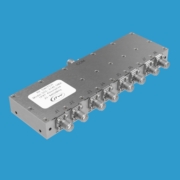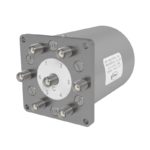How do I choose a RF switch?
When choosing a RF switch, you must first determine which type of switch best suits your application. There are electro-mechanical switches and solid-state switches. Both types of switches perform the same function (i.e. route RF signals), but each have key differences in RF performance. Below we list a description of each type of RF switch and their differences for several important RF specifications.
Description: Electro-mechanical RF Switches
Electro-mechanical switches use metal contacts that are physically moved inside the switch to route the RF signal through the switch. Lifetime of mechanical switches is typically 1 million cycles. Mechanical wear of the contacts will eventually cause a switch failure. The RF path through a mechanical switch has no active components so the RF signal has very low distortion (i.e. -120dBc typical standard models).
For electro-mechanical switches there is a significant cost difference (i.e. 2 times or more) between models that are reflective and those that are absorptive (i.e. self-terminating). The reflective models are lower cost. An absorptive electro-mechanical switch has more internal parts to add the self-terminating functionality which results in a higher cost.
Description: Solid-state RF Switches
Solid-state switches use active components (PIN diodes, FETs) to route the RF through the switch. Because these active components are in the RF path, a solid-state switch will always have higher insertion loss than an electro-mechanical switch. The advantage of the PIN diodes/FETs is their lifetime. They have no mechanical wear and typical MTBF of 200,000 hours. The disadvantage is that the active components cause more signal distortion than electro-mechanical switches. A solid-state switch has a typical third order intercept point (IP3) of +45dBm.
Key RF Specifications:
Lifetime
Solid-state: typical MTBF of 200,000 hours (always superior to electro-mechanical)
Mechanical: 1 million operations typical
Frequency Range
Solid-state: Operate over a specific band (i.e. 20-6000MHz, 0.5-18GHz)
Mechanical: Operate from DC to an upper limit (i.e. DC-18GHz, DC-40GHz)
Impedance
Solid-state: 50 Ohm or 75 Ohm
Mechanical: 50 Ohm or 75 Ohm
VSWR
Solid-state: 1P2T = 1.28:1 typical @ 4 GHz
Mechanical: 1P2T = 1.035:1 typical @ 4 GHz (typically superior to solid-state)
Insertion Loss
Solid-state: 1P2T = -1.7dB typical @ 4 GHz
Mechanical: 1P2T = -0.0445dB typical @ 4 GHz (always superior to solid-state)
Isolation
Solid-state: 1P2T = -66dB typical @ 4 GHz
Mechanical: 1P2T = -105dB typical @ 4 GHz (typically superior to solid-state)
Switching Speed
Solid-state: nanoseconds or microseconds (always superior to electro-mechanical)
Mechanical: milliseconds
Signal Distortion
Solid-state: typical third order intercept point (IP3) of +45dBm
Mechanical: typical PIM -120dBc for standard models (always superior to solid-state)
Control
Solid-state: TTL or USB
Mechanical: +12V, +15V, +24V, +28V, TTL, or GND activated
Cold Switch RF Input Power
Solid-state: up to 1W for low power models and 250W for high power models
Mechanical: in the order of 400W @ 200MHz, 90W @ 8GHz, 60W @ 18GHz
Hot Switch RF Input Power
Solid-state: Can hot switch specified RF input power without causing damage to RF switch
Mechanical: High power hot switching leads to arcing which damages the internal switch contacts
Available Models:
50 Ohm Models
- Electro-Mechanical (absorptive): unused ports self-terminating at 50 Ohm
- Electro-Mechanical (reflective): unused ports open
- Solid-State (absorptive): unused ports self-terminating at 50 Ohm
- Solid-State (reflective): unused ports open
- High Power Solid-State: 15W to 250W models



